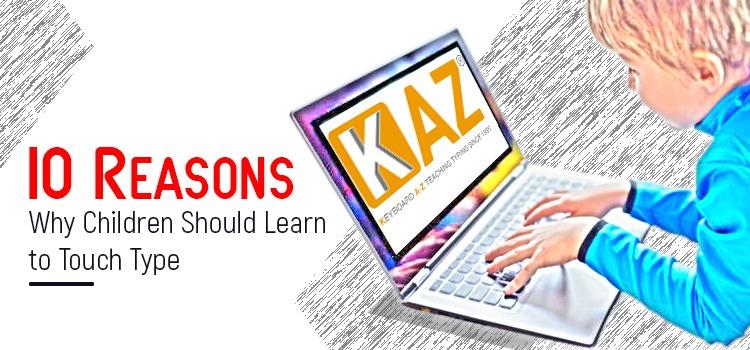Touch typing - the phrase seems to evoke a mental image of rows of immaculately groomed young ladies sitting and typing away at manual typewriters. Indeed, typing as an industrially useful skill was once the staple of secretaries everywhere, who invariably were females. The Second World War further reinforced this, as many women were employed at desk jobs at home while the men went off to war. However, the scenario started changing as women started moving out of secretarial positions and into other fields. Once a highly valued skill, typing today appears to be going slowly but surely out of fashion with the inexorable rise of technological marvels such as mobile internet and voice recognition.
However, the real situation is not as grim. In fact, far from becoming an outdated practice, touch typing actually has the potential of becoming one of the most valued skills that a primary school child could learn. You might ask why? Here, we take a look at a few reasons why we believe every child should learn keyboarding as a basic life skill.
-
Improves working speed:
Touch typing increases speed. It teaches you to type fast and with accuracy, without looking at the keyboard between keystrokes. Constantly shifting focus between the screen and the keyboard stresses the brain, making you both inaccurate and slow, and this effect is far more pronounced in children. Even those who can type fast but cannot touch type work slower than those who do, as they still need to read the screen to identify and correct mistakes. In fact, studies have shown that children who learn touch typing take nearly half the time to complete work, compared to those who ‘hunt and peck’ at the keyboard to type.
-
Advantage over peers:
Touch typing is a life skill, and like any other skill, children who master it gain an immediate advantage over their peers who don’t. Children who know how to touch type work at nearly double the speed than the rest. A definite advantage in our opinion.
-
Best time to learn:
Touch typing is considered somewhat of a grown-up skill. However, science and research tells us that primary school children are perfectly placed to learn new skills. They have the necessary concentration span, their minds are more pliant, their hands are the correct size, and most of all children love computers! While you can always learn touch typing later in life, the more you put it off, the more bad practice you pick up. Undoing, retraining and learning new skills can be tough.
-
Advantages in the future:
With computers becoming integrated into practically every aspect of our lives, it will not be long before all exams are taken on computers. Instead of written exams, candidates will be expected to type out their answers, which is already the norm in a number of countries. Additionally, the majority of jobs today, even something as simple as maintaining records require computer literacy and skills. Emails have become the preferred mode of official communication worldwide. The advantages of touch typing should now be apparent. Learning at a young age gives children more time to practice and become proficient.
-
Great assistive tool for dyslexic children:
With neurological differences such as dyslexia and autism getting more and more positive attention, we are continually searching for ways to help children with these conditions adjust and learn, without hampering their mental or physical development. Large bodies of evidence suggests that learning how to touch type can give neurodivergent children a very distinct advantage. The British Dyslexic Association maintains that a great percentage of children with dyslexia find it easier to type than write by hand, since typing requires tactile (touch based) interaction with individual letters in a word, along with visual, providing help in managing words. Additionally, computers, unlike humans, are neither impatient nor judgmental with special needs children, automatically giving them the necessary confidence boost they need to help them learn.
-
Learning is quick:
Touch typing may seem like a complicated skill to learn but in reality, children can learn and master it very quickly. Data from multiple studies indicate that children can easily achieve speeds of up to 30 to 40 words per minute in a mere 10 weeks with just 10 to 20 minutes of daily practice.
-
Improves quality of content:
Apart from typing speed, one of the understated benefits of touch typing is that it improves the quality of work produced. Once mastered, touch typing becomes an unconscious practice, allowing attention and cognition free reign over the actual content of what is being written. Thoughts are captured, allowing time for planning, processing, composing, proof reading and editing.
-
Reduces adverse health risks:
Unlike ‘hunt and peck’ typists who u:se only one or two fingers to type, touch typists use all of their fingers. This greatly reduces the risk of Repetitive Stress Injuries (RSI), a particularly harmful condition for youngsters. Additionally, fast and accurate touch typing allows children to finish their work quickly, reducing time hunched over the keyboard and allowing more time to play. It is always essential to take intermittent breaks whilst typing.
-
Fun factor:
Learning touch typing skills does not have to take hours or be filled with boring exercises. Programs can be delivered using a multi-sensory approach and in a light hearted manner, engaging children. This makes learning fun and enjoyable, naturally speeding up the learning process.
-
A new life-skill:
Much like walking, swimming, or riding bicycles, touch typing is a skill that lasts a lifetime once mastered. It is easy for children to learn, and once muscle memory develops, it is engrained for life.
